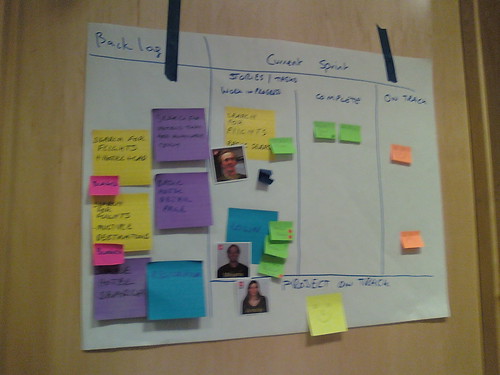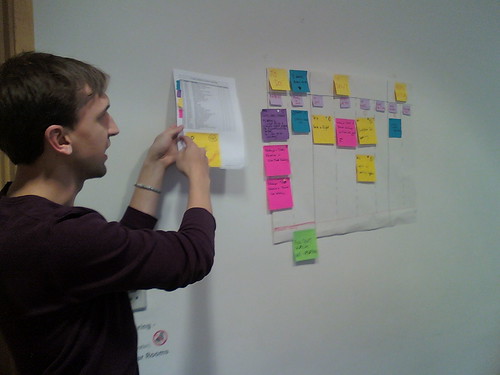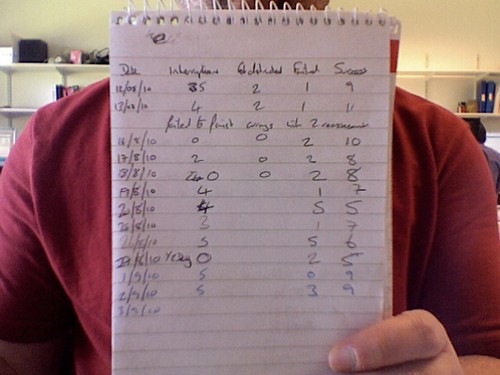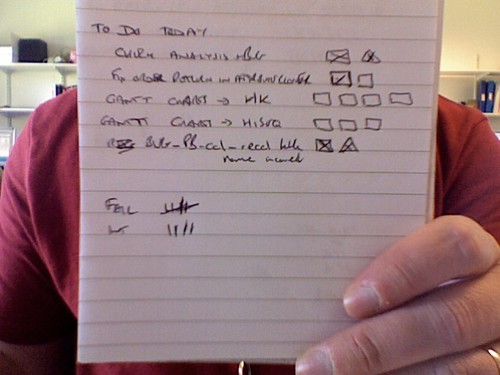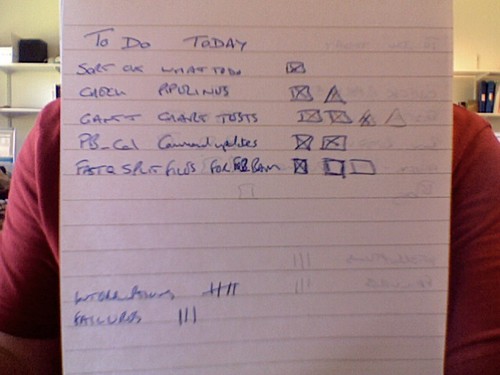Agile Cambridge 2010
Day 1
With much excitement I left Haverhill on the first bus of the day in order to go to the conference. There was method to this madness, since the plan was drinks in the evening, and I wasn't going to pass that opportunity up.
I left with laptop, plan of the sessions I ideally wanted to achieve, and the bits for my lightning talk.
I arrived at Murray Edwards College around 8.30, and found those of my colleagues (Beth Jones and Conny Brunkvist) who were also attending. Also picking up a pack and some freebies from RedGate Software (choccies!)
At 9 we went through for the welcome talk (Mark Dalgarno - Software Acumen) and the first Keynote.
The Keynote was James A. Whittaker (Google) who delighted us all with his running of test at Google.
As well as unit tests and functional tests, they also have a suite of different Tours, which are designed to go off and fully test the whole applications under different situations, but which are named rather 'cleverly' (I would love to know what 'The Couch Potato Tour' is). He also showed us problems that had been sent in with Google Maps, including the best route to walk from Cambridge to Hull is taking the ferry via Holland.
He also seemed rather surprised that over half of the audience had actually used a phone book in the last 6 months. Clearly a difference between Americans and Brits.
After the first coffee break (good letting them be 30 mins, allows plenty of time to chat!), it was the first sessions with choices. I opted for the Workshop 'The Specification Game', since one thing I admit I am bad on is getting specifics up front, and in the end, this only proved it.
Gojko Adzic and David de Florinier introduced us to a 'simple task'. They were hiring (i.e. they were the customer - note that, I'll come back to it) us to do them a blackjack application. We were to go through the first iteration, and should produce them something which was playable. We needed a business/project owner (that was anyone who knew blackjack - me!) and at least one dev and 1 tester.
This was were we made our second mistake, (the first being that we completely forgot they were the customer). We went for having the dev and tester as separate people.
I spec'd out what I thought we could achieve in the first iteration, (not negotiating at all with the customer), and we went for it. I went for a playable version which wouldn't bother with betting, but would check blackjack, that the dealer would deal correctly, and would say if the player or the dealer won.
At the end of the time allowed, it is safe to say that we failed. Reasons:
1) Some of my specs weren't good enough
2) One of my specs wasn't dealt with
3) I spent too much time helping the tester, than guiding my two devs and the tester
4) I never consulted with the customer for any user acceptance tests
5) I never consulted with the user for exactly what they wanted in the first iteration, and negotiated that it was too much for my team
So, I accept the failure.
Initially afterwards we felt a bit aggrieved since the one thing that everyone in the room had failed to realise was that Gojko and David were our customers, and so we never felt we could consult with them, you notice that I mentioned that they did tell us this up front, so we all failed because we never got them to discuss with us the specifications. We chatted with Gojko nd David, and found that this was what they were trying to get across to us, and that this is the biggest problem with the specifications is that we forget to/or just don't get the customer involved in what to do that iteration. Also the other was that we never asked the customer for UATs, so when we finally got some, they inevitably failed. Also, no-one did the tests before the development. Whilst they said there must be at least one Dev and one Tester, they never said that they couldn't be the same person.
I think that this was an excellent session. One that I have certainly taken a lot away from.
After lunch, I went for the Hands-On session Code Debt (David Harvey and Peter Marks). This was a break away from Agile, but I was interested in seeing exactly what was meant by it (the term is bandied around a fair bit, but not with any real explanation). The best definition of Code Debt that was mentioned is 'It is code that you owe time to'.
We all have written terrible code (I am sure I still do). The purpose of the first exercise was to change/add to some javascript code to make a new set of tests of that code pass. We were given 10 minutes. Some in the group managed it, some didn't. What we were unaware of at the time was that one side of the group were given nice concise well written javascript, and the other just javascript that worked (it was all done via TDD), but had no best practice about it. As such it was essentially unmaintainable code, and us such, they weren't expected to be able to do the task.
And this seemed to be pretty much the point of the session. If the code just does the job, but hasn't been thought about (idiosyncrasies of the language, meaningful function/variable names, refactored) then there is some level of debt owed to the code to get it to that point.
It was a good workshop to have attended, but in this case, I think a little out of place at a conference about Agile, and possibly a bit too much time spent getting over the one point. Refactor and make sure that your naming means something. Still, well presented. (And I also discovered I was probably the only Perl programmer there - or at least willing to admit it).
Another coffee break, and the onto 'Understanding the Agile Mind: How Mindsets Transform as Organisations Rightshift Effectiveness' (Bob Marshall - Falling Blossoms twitter @flowchainsensei)
I had shared a few words with Bob at lunch (we seemed to have managed to be at all the same sessions so far), but hadn't actually twigged he was running this session.
The focus of this workshop was looking at how organisations worked at the effectiveness multipliers that give serious increases in production with lot less waste, but are so far above the norm, that the mindset seems 'Alien' to most. Working in small groups, we tried to come up with things that we thought companies that were at 0/1/2/3/4/5x effectiveness (1x being the norm) would be doing. Bob then mentioned
the 4 different types of organistional styles (Ad-Hoc, Analytic (sometimes called Mechanistic), Holistic/Synergistic and Chaordic) (I've just found a
pdf paper by Bob about this)
I think that clearly this is a huge area to look into (I admit by this time of the day I was more thinking about the pub - sorry Bob), but looks incredibly interesting, and I shall be taking the time to read the above paper soon.
After another coffee break, we had the final session of the day, and a chance for me to Do My Stuff. So, obviously, I attended the Lightning talks (since I was presenting one). I should have gone first, but as with all things, the projection system decided to take that opportunity to have a nap, so I got a bit delayed.
The other talks were really interesting though. Nick ably stepped up to now go first, with some interesting insights into how agile and scrum very much mimics how humans have always done things, including that daily scrums are like sitting around the tribal campfire.
Bob then came up, with an explanation of how he came up with his twitter moniker. Tiss from RedGate (I think rather badgered into it by Helen) did some Improv very Whose Line is it Anyway. I then gave my talk on The Pomodoro Technique (
see previous blog post), and then Alan Kelly came on to show how 'Doing it Right' against 'The Right (Business Aligned) Way to do it' affects the productivity, cost and sales. Took me right back to A-Level Economics, but a reminder of how things need levels of thought and balance.
After this, a move to the Castle Inn, for a well earned pint (or four) and food, all courtesy of those fine fellows at RedGate, who I spent most of the night chatting to, along with others who were there. (Sorry guys, I can't remember most of your names and it seems that there was no delegate list in the pack).
I left the pub (unfortunately rather abruptly - big apologies to those I was talking to at the time) in order to catch the bus back to Haverhill. I though some sleep might be useful before the following day.

